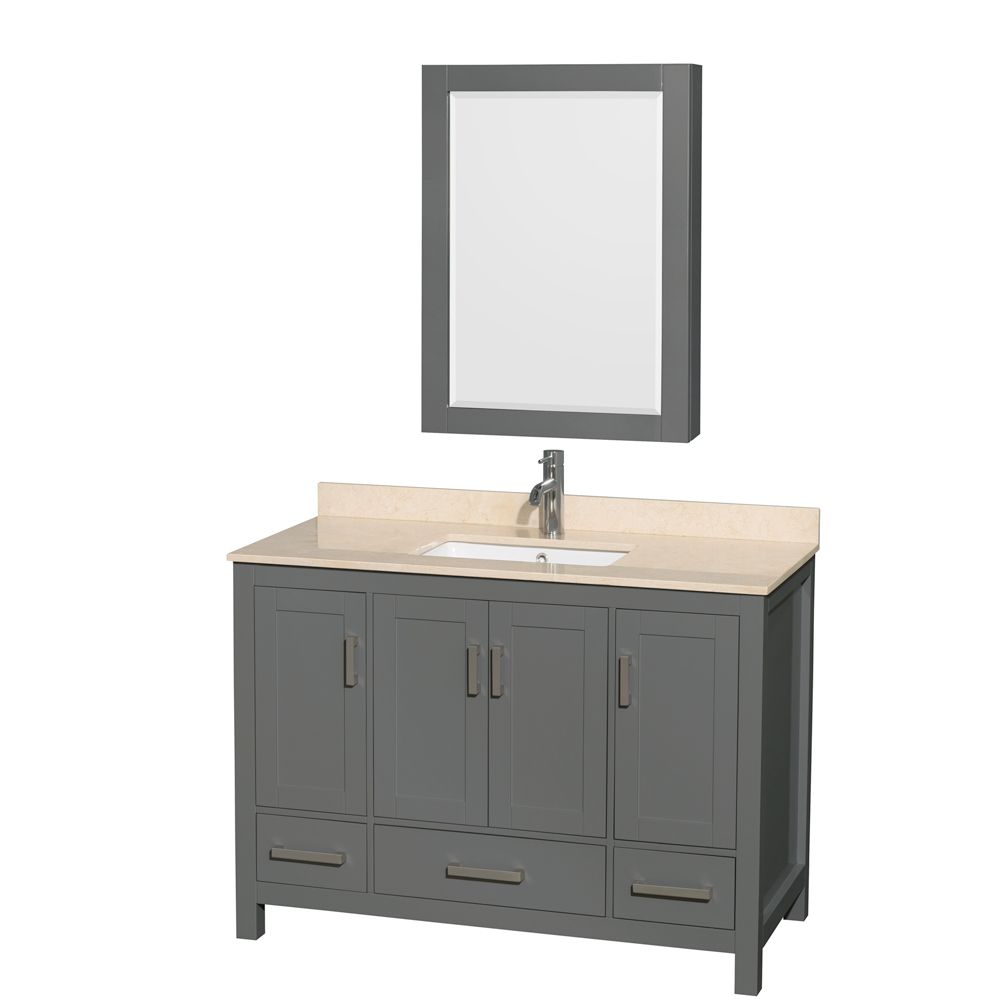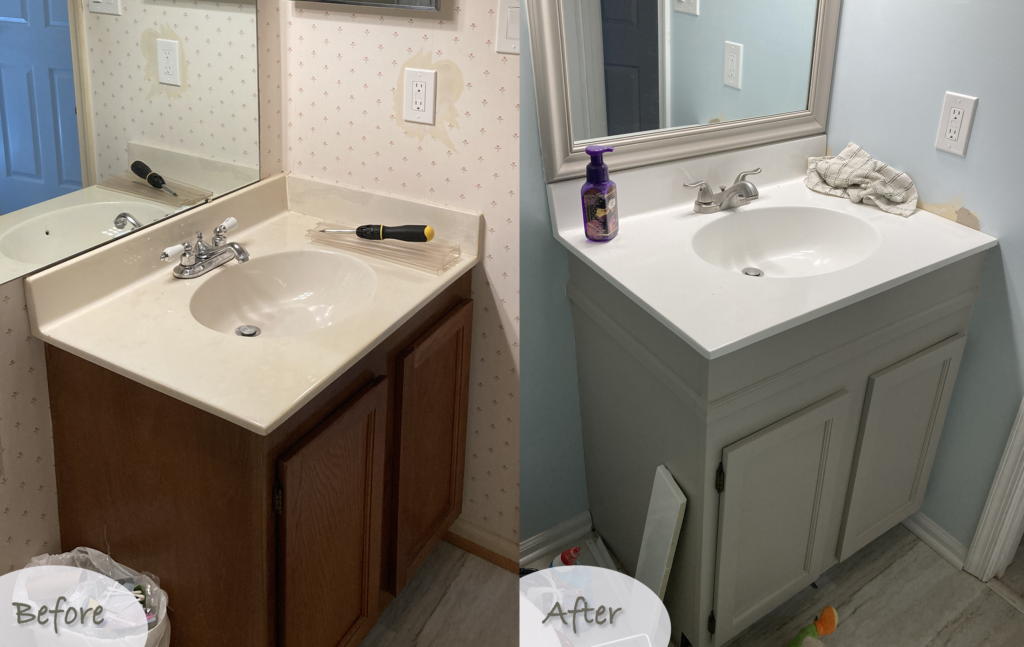Understanding the Need for a Taller Vanity: How To Make Bathroom Vanity Taller
:max_bytes(150000):strip_icc()/sarahshermansamuelphotoanddesign-c65ca4291b3c467dac85246c35c92343.jpg)
A taller bathroom vanity can significantly enhance both functionality and aesthetics, catering to various user needs and preferences. It’s more than just a matter of style; it can improve accessibility, comfort, and overall bathroom experience.
Factors Influencing Vanity Height
The ideal height for a bathroom vanity is determined by several factors, including user height, mobility, and intended use.
- User Height: A taller vanity is essential for individuals who are above average height, ensuring comfortable access to the sink and countertop. It prevents them from having to bend or stoop excessively, reducing strain on their back and neck.
- Mobility: For people with limited mobility, such as those using wheelchairs or walkers, a taller vanity provides easier access and reduces the risk of falls. It allows them to comfortably reach the sink and countertop without needing to strain or compromise their balance.
- Intended Use: If the vanity is primarily for personal grooming activities, such as applying makeup or shaving, a slightly taller countertop can provide better visibility and a more comfortable working space.
Methods for Raising a Bathroom Vanity

Raising a bathroom vanity can be a simple and effective way to improve comfort and accessibility. Several methods can be used to achieve the desired height, each with its own advantages and disadvantages.
Adding Legs or Risers
Adding legs or risers is a common and relatively easy method for raising a bathroom vanity. This approach involves attaching pre-made legs or risers to the existing base of the vanity.
Adding legs or risers is a quick and easy way to increase the height of a vanity, but it may not be suitable for all vanities.
- Advantages:
- Easy installation.
- Affordable.
- Wide variety of styles and materials available.
- Disadvantages:
- May not be sturdy enough for heavier vanities.
- Can limit the storage space under the vanity.
- May not match the existing style of the vanity.
Step-by-Step Instructions:
- Measure the desired height: Determine the height increase needed and select legs or risers accordingly.
- Prepare the vanity: Clean the bottom of the vanity and mark the locations for the legs or risers.
- Attach the legs or risers: Use screws or other appropriate fasteners to secure the legs or risers to the vanity base.
- Level the vanity: Ensure the vanity is level after installation by adjusting the legs or risers as needed.
Tools and Materials:
- Measuring tape
- Level
- Screwdriver or drill
- Screws or other fasteners
- Legs or risers
Illustrations:
Imagine a vanity with four legs. To raise it, you would attach four new legs, each slightly taller than the original ones, to the bottom of the vanity. The new legs would be secured using screws or other fasteners, ensuring they are level and stable.
Using Shims or Spacers
Shims or spacers are thin, wedge-shaped pieces of material that can be used to raise a vanity slightly. They are often used to level a vanity or to adjust its height by a small amount.
Shims or spacers are a simple and inexpensive way to adjust the height of a vanity, but they may not provide sufficient height increase for all situations.
- Advantages:
- Easy to install.
- Affordable.
- Can be used to level a vanity.
- Disadvantages:
- Limited height increase.
- May not be sturdy enough for heavier vanities.
- Can be difficult to adjust once installed.
Step-by-Step Instructions:
- Measure the desired height: Determine the height increase needed and select shims or spacers accordingly.
- Prepare the vanity: Clean the bottom of the vanity and mark the locations for the shims or spacers.
- Install the shims or spacers: Place the shims or spacers under the vanity legs or base, ensuring they are level and secure.
- Secure the vanity: Use screws or other appropriate fasteners to secure the vanity to the floor or wall.
Tools and Materials:
- Measuring tape
- Level
- Screwdriver or drill
- Screws or other fasteners
- Shims or spacers
Illustrations:
Imagine a vanity with four legs resting on the floor. To raise it slightly, you would place thin wooden shims or plastic spacers under each leg, ensuring they are level and provide the desired height increase.
Replacing the Existing Base with a Taller One
Replacing the existing base with a taller one is a more involved method, but it can provide a significant height increase and a more integrated look. This involves removing the existing base and installing a new, taller base.
Replacing the existing base with a taller one is a more permanent solution that offers greater height increase and a more integrated look, but it can be more time-consuming and expensive.
- Advantages:
- Provides significant height increase.
- Offers a more integrated look.
- Can improve the overall style of the vanity.
- Disadvantages:
- More time-consuming and expensive.
- May require professional installation.
- May not be compatible with all vanities.
Step-by-Step Instructions:
- Remove the existing base: Disconnect the plumbing and remove the existing base from the vanity.
- Prepare the new base: Ensure the new base is compatible with the vanity and is the desired height.
- Install the new base: Attach the new base to the vanity using screws or other appropriate fasteners.
- Reconnect the plumbing: Reconnect the plumbing and test for leaks.
Tools and Materials:
- Plumbing tools
- Screwdriver or drill
- Screws or other fasteners
- New base
Illustrations:
Imagine a vanity with a short base. To raise it significantly, you would remove the existing base and replace it with a taller one. The new base would be designed to fit the vanity and would be secured using screws or other fasteners.
Building a Custom Platform
Building a custom platform is the most involved method but allows for complete control over the height and design. This involves constructing a platform to support the vanity, providing the desired height increase.
Building a custom platform offers the greatest flexibility and customization, but it requires more time, effort, and skills.
- Advantages:
- Provides complete control over height and design.
- Can be customized to match the existing style of the vanity.
- Offers a sturdy and durable solution.
- Disadvantages:
- More time-consuming and labor-intensive.
- Requires more skills and tools.
- May be more expensive.
Step-by-Step Instructions:
- Plan the platform: Determine the desired height and design of the platform.
- Gather materials: Choose appropriate materials for the platform, such as plywood, lumber, or other suitable materials.
- Construct the platform: Cut and assemble the platform according to the plan, ensuring it is level and sturdy.
- Install the vanity: Place the vanity on the platform and secure it using screws or other appropriate fasteners.
Tools and Materials:
- Measuring tape
- Level
- Saw
- Screwdriver or drill
- Screws or other fasteners
- Plywood, lumber, or other suitable materials
Illustrations:
Imagine a vanity sitting on a custom-built platform made of plywood or lumber. The platform would be designed to support the vanity securely and provide the desired height increase. The platform could be constructed with a simple rectangular shape or a more elaborate design, depending on the desired look and functionality.
Considerations for a Taller Vanity

Raising a bathroom vanity can significantly impact its functionality and aesthetics. It’s crucial to carefully consider the implications of such a change before proceeding.
Adjusting Plumbing and Electrical Connections
Raising a bathroom vanity may necessitate adjusting plumbing and electrical connections.
- Plumbing: The height of the sink drain and water supply lines must be adjusted to accommodate the taller vanity. This might involve extending the drain pipe or using a taller trap. You might also need to relocate the water supply valves if they are too low.
- Electrical: If the vanity has an electrical outlet, you may need to extend the wiring or relocate the outlet to accommodate the new height. This is especially important if the outlet is used for a vanity light or electric toothbrush charger.
Adjusting the Sink and Mirror
The sink and mirror must be adjusted to maintain a comfortable and functional bathroom setup.
- Sink: The sink should be installed at a height that allows for comfortable handwashing and brushing. A standard sink height is around 34 inches, but this can be adjusted based on personal preference and the height of the vanity.
- Mirror: The mirror should be positioned above the sink at a height that allows for easy viewing and prevents glare. It is generally recommended to place the bottom of the mirror about 6 inches above the sink.
Ensuring Stability and Security, How to make bathroom vanity taller
A taller vanity needs to be adequately supported to ensure stability and prevent it from tipping over.
- Sturdy Base: The vanity’s base should be strong enough to support the added weight. If the existing base is not sturdy, you may need to reinforce it or use a different base altogether.
- Secure Anchoring: The vanity should be securely anchored to the wall using appropriate fasteners. This is particularly important for taller vanities, as they are more susceptible to tipping.
- Even Weight Distribution: Ensure the weight of the vanity is evenly distributed to prevent it from tipping. Avoid placing heavy objects on one side of the vanity.
Coordinating Vanity Height with Other Bathroom Fixtures
A taller vanity can alter the overall balance of your bathroom. It’s essential to consider how the new height will coordinate with other fixtures and furniture.
- Shower/Bathtub: The height of the vanity should be in proportion to the shower or bathtub. A taller vanity may make the shower or bathtub feel lower.
- Toilet: The height of the vanity should complement the height of the toilet. If the vanity is significantly taller than the toilet, it can create an awkward visual imbalance.
- Bathroom Storage: The height of the vanity should also be considered in relation to other bathroom storage units. A taller vanity might necessitate adjustments to the height of other storage units.
How to make bathroom vanity taller – Yo, if your bathroom vanity is too low, it’s a total vibe killer. Maybe you need to add some extra height to it. You could always try stacking some storage boxes underneath, or you could even check out this awesome wood bathroom corner shelf that’ll add some serious storage and style.
Whatever you do, make sure you make your vanity taller so you can rock those bathroom vibes.
Yo, if your bathroom vanity is too short, it’s a total vibe killer. You could always stack some boxes or something, but if you want a more permanent fix, maybe consider a natural wood bathroom vanity. Check out this site for some awesome options: natural wood bathroom vanity.
They’re super stylish and can really elevate your bathroom game. Plus, you can always get one that’s the perfect height for you. So ditch the boxes and upgrade your bathroom with a killer vanity!